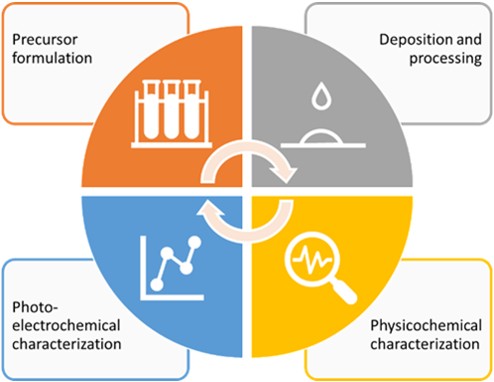Solution-Processed Mixed-Anion Semiconductors for Selective CO₂ Reduction in PEC Devices
PhD - Hasselt | More than two weeks ago
Photoelectrochemical (PEC) systems present a promising technology for converting light into chemical energy by using photoanodes and/or -cathodes to initiate redox reactions via electron-hole pair generation. The choice of the semiconducting photo-absorber plays a critical role in the PEC performance, requiring materials that meet specific criteria such as strong absorption of visible light, efficient separation and extraction of photogenerated charge carriers, and stability in electrolyte solutions under irradiation. Single-anion materials, primarily oxides and chalcogenides, exhibit photocatalytic activity but have known limitations. Oxide semiconductors suffer from poor charge carrier mobility and high recombination rates, leading to reduced efficiency, and their large bandgap ensures strong redox potential, but weakens the absorption of visible light. Sulfides and selenides, on the other hand, are more prone to photo-corrosion, constraining their long-term operational stability. Mixed-anion semiconductors are a class of materials that incorporate multiple anionic species within their lattice structures. This compositional flexibility introduces unique properties and advantages, making them promising candidates for photoelectrochemical applications. For instance, introducing softer anions, such as chalcogenides, into an oxide sublattice to create mixed-anion oxychalcogenides, leads to hybridization of the anion p orbitals. This hybridization results in several benefits: (1) it raises higher energy states at the top of the valence band, effectively reducing the band gap; (2) it enhances the dispersion of the valence and conduction bands, leading to improved transport properties for charge carriers; and (3) it provides greater durability against photo-corrosion. Nonetheless, the relationship between compositional and structural features and PEC performance is poorly understood, especially for complex CO2 reduction reactions, and a systematic approach for selecting a suitable compound is often lacking. Additionally, mixed-anion semiconductors are challenging to synthesize with high phase purity and controlled defect chemistry. Existing methods are often solid-state, which lack compositional precision and are not easily transferable for thin-film fabrication.
In this project, we aim to develop high-performance mixed-anion oxychalcogenide semiconductors specifically engineered for selective photoelectrochemical CO2 reduction. The synthesis of mixed-anion photo-absorbers will be achieved via either a one-step or a two-step solution-based approach. In the two-step method, existing solution-gel precursor formulations will first be used to deposit uniform metal oxide coatings onto substrates. These oxide layers will then undergo post-deposition annealing in a chalcogen-containing atmosphere, leading to partial sulfurization or selenization, thereby forming the targeted mixed-anion oxychalcogenide phase. In the one-step method, the solution-gel precursor formulation will be modified to include both metal and chalcogenide sources from the start. This aims to enable direct synthesis of oxychalcogenide coatings in a single deposition and heat-treatment step. The precursor solutions, intermediates, and final coatings will undergo a thorough set of physicochemical and (photo)electrochemical characterization techniques. This approach will enable us to generate both fundamental and applied knowledge about the relationship between synthesis parameters, physicochemical characteristics, and the (photo)electrochemical performance of the materials. Finally, the most effective oxychalcogenide photoabsorber will be selected and integrated into a photoelectrode stack by combining it with suitable electron- or hole-transfer layers and appropriate co-catalysts for selective CO2 reduction.
Scientific Relevance:
- Solar-driven photo-electrochemical CO2 reduction is critical for renewable fuel production and carbon neutrality.
- Mixed-anion semiconductors combine oxide stability with the electronic advantages of chalcogenides.
- Novel solution-based methods for thin-film oxychalcogenides will facilitate scalable, high-throughput synthesis
Expected Scientific Output:
- Materials Chemistry
- Tuning of band structure through anion hybridization.
- Insights into phase stability and defect chemistry.
- Synthetic Methodology
- Scalable and controlled solution-based synthesis routes.
- Comparative evaluation of one-step versus two-step strategies.
- Photoelectrochemical Performance
- Correlations between structure, properties, and performance.
- Integration with co-catalysts for selective CO₂ reduction.
- Assessment of stability under photoelectrochemical (PEC) conditions.
The majority of the PhD research will be carried out in the Science Tower of UHasselt (imo-imomec, Campus Diepenbeek) with state-of-the-art equipment for synthesis, processing, chemical and photoelectrochemical characterisation.

Required background: Materials Chemistry (inorganic), Electrochemistry or equivalent
Type of work: 50% experimental work , 30% characterization & validation, 20% literature & dissemination
Supervisor: Marlies Van Bael
Co-supervisor: Ken Elen
Daily advisor: Ken Elen
The reference code for this position is 2026-069. Mention this reference code on your application form.
